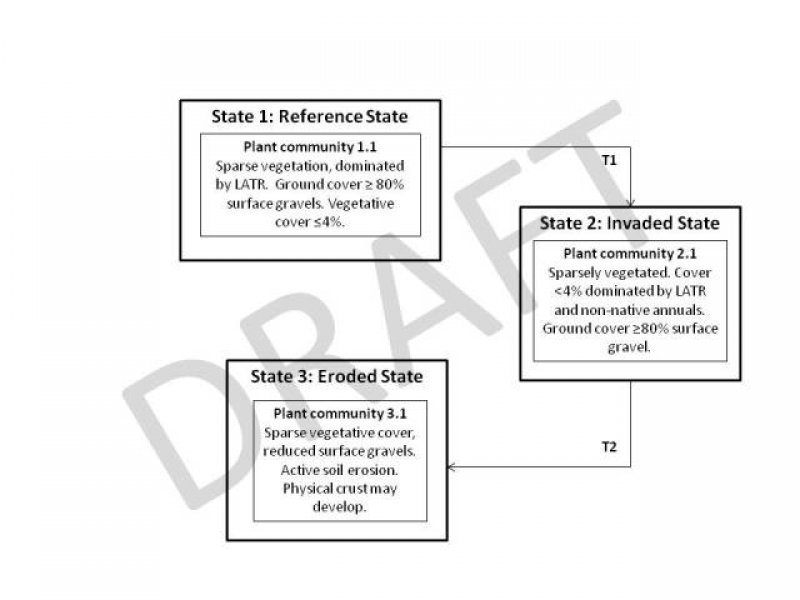Ecological dynamics
This is a very stable plant community so long as the desert pavement is not disturbed. This is a very low producing site with very restricted plant diversity. Annual forbs account for most of the variability in production. Introduced annual forbs and grasses may invade this site.
Most fires in the Mojave Desert are infrequent and of low severity because production of annual and perennial herbs seldom provides a fuel load capable of sustaining fire. Fires in creosotebush scrub were an infrequent event in pre-settlement desert habitats, because fine fuels from winter annual plants were probably sparse, only occurring in large amounts during exceptionally wet winters. Fire kills many creosotebush. Creosotebush is poorly adapted to fire because of its limited sprouting ability. Creosotebush survives some fires that burn patchy or are of low severity. Range ratany is a drought tolerant perennial. It is generally considered to be a climax species in desert communities. It is a valuable browse plant, however under heavy grazing pressure it will decrease. The intricately branched round shape of range ratany provides valuable shelter for small mammals and birds. Range ratany generally reproduces sexually from seed, but has also been known to sprout post fire (Griffith 1991).
Desert pavement formed as a function of eolian erosion and deposition, therefore the site is not vulnerable to wind erosion if surface clasts are intact. If disturbed, the fine grained materials of the vesicular horizon will be released into the air potentially causing ecological and health problems (Yonovitz and Drohan 2009). Anthropogenic disturbances disrupt the pavement surface and increase erosion. However, studies have shown that soil functions related to pore morphology are not significantly affected by disturbance. Characteristics of the vesicular horizon, including the non-connected nature of the pores and its effect on restricting infiltration are able to rapidly recover to pre-disturbance conditions (Yonovits and Droham 2009). The implications of this are that the increased availability of nitrogen will not facilitate increase vegetative growth because infiltration will continue to be impeded even following disturbance.
Well-developed desert pavements can require thousands of years to form (Graham et al. 2008). Even at maturity, pavement surfaces are characterized by a dynamic stability. Stone mobility is an important aspect of pavement longevity. Disturbances can also be repaired by this process if not too extensive (Haff and Werner 1996). Natural mechanisms influencing stone mobility include animal movement and running water.
State 1
Reference State
This state is representative of the natural range of variability under pristine conditions. Plant community phase changes are primarily driven by long-term drought. Insect attack and wildfire are infrequent, but have long-term impacts on the plant community. The plant communities of this site are dynamic in response to changes in disturbance regimes and weather patterns.
Community 1.1
Reference Plant Community
The reference plant community is dominated by creosotebush.
Potential native vegetative composition is about 5% perennial and annual forbs and 95% shrubs. Approximate ground cover (basal and crown) is less than 4 percent.
Table 5. Annual production by plant type
| Plant type |
Low
(lb/acre) |
Representative value
(lb/acre) |
High
(lb/acre) |
| Shrub/Vine |
23 |
71 |
143 |
| Grass/Grasslike |
1 |
2 |
4 |
| Forb |
1 |
2 |
3 |
| Total |
25 |
75 |
150 |
State 2
Invaded
The Invaded State is characterized by the presence of non-native annuals in the understory. A biotic threshold has been crossed, with the introduction of non-native annuals that cannot be removed from the system. Ecological resiliency has been reduced by the presence of non-native annual species and a reduction in the cover of desert pavement. Non-native species have the potential to alter disturbance regimes significantly from their natural or historic range of variability.
Introduced annuals such as red brome, schismus and redstem stork's bill have invaded the reference plant community and have become a dominant component of the herbaceous cover. This invasion of non-natives is attributed to a combination of factors including: 1) surface disturbances, 2) changes in the kinds of animals and their grazing patterns, 3) drought, and 4) changes in fire history. These non-natives annuals are highly flammable and promote wildfires where fires historically have been infrequent.
Community 2.1
Plant Community Phase 2.1
This community is compositionally similar to the Reference Plant Community, with the presence of non-native annuals and reduced surface gravels. Following small scale disturbances desert pavements are able to heal due to the mobility of surface clasts. This plant community is identified as “at-risk”. If surface disturbance is not discontinued the site will be highly susceptible to erosion.
State 3
Eroded State
The Eroded State is characterized by persistent and severe surface disturbance, reduced vegetative cover and increased bare ground. A biotic threshold has been crossed, with the loss of long-lived native vegetation. This threshold causes changes in abiotic components of the site leading to active soil erosion.
Community 3.1
Plant Community Phase 3.1
This plant community is characterized by loss of perennial vegetative cover and reduced surface gravels. Non-natives are present in the plant community. Rain, wind, and surface water all contribute to increased erosion. Ecological processes including infiltration and nutrient cycling are severely reduced.
Transition 1
State 1 to 2
The introduction of non-native species due to anthropogenic disturbances including OHV use, dry land farming, grazing, linear corridors, mining, military operations and settlements.
Transition 2
State 2 to 3
Continued surface disturbances will disturb protective surface creating an eroded state.

